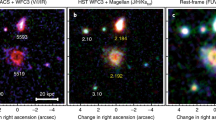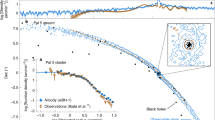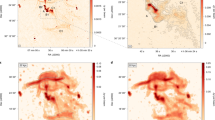Abstract
FOUR very large, shell-shaped features are known from the surveys of radio emission from the Galaxy. Ranging in angular diameter from 40° (Loop IV) to 116° (Loop I, the North Polar Spur), they are polarized, nonthermal radio sources that appear to be associated with faint optical emission nebulae. These objects, formerly known as the galactic spurs, have recently been reviewed by the group at Manchester which has been responsible for much of the observational and theoretical work on them1. The term “spurs” seems to have given way to that of “loops”. We prefer to call them “giant loops”, because we believe that these objects represent a different phenomenon from that typified by the much smaller Cygnus Loop to which they are frequently compared.
This is a preview of subscription content, access via your institution
Access options
Subscribe to this journal
Receive 51 print issues and online access
$199.00 per year
only $3.90 per issue
Buy this article
- Purchase on Springer Link
- Instant access to full article PDF
Prices may be subject to local taxes which are calculated during checkout
Similar content being viewed by others
References
Haslam, C. G. T., Kahn, F. D., and Meaburn, J., Astron. Astrophys., 12, 388 (1971).
Hanbury Brown, R., Davies, R. D., and Hazard, C., Observatory, 80, 191 (1960).
Tunmer, H., Phil. Mag., Series 8, 3, 370 (1958).
Mathewson, D. S., Astrophys. J. Lett., 153, L47 (1968).
Ilovaisky, S. A., and Bowyer, S., Nature, 233, 470 (1971).
Bingham, R. G., Mon. Not. Roy. Astron. Soc., 137, 157 (1967).
Berkhuijsen, E. M., Haslam, C. G. T., and Salter, C. J., Astron. Astrophys., 14, 252 (1971).
Milne, D. K., Austral. J. Phys., 23, 425 (1970).
Downes, D., Astron. J., 76, 305.
Shklovski, I. S., and Sheffer, E. K., Nature, 231, 173 (1971).
Zuzak, W. W., Astron. Astrophys., 15, 95 (1971).
Maran, S. P., and Modali, S. B., Earth Extraterr. Sci., 1, 147 (1970).
Brandt, J. C., Stecher, T. P., Crawford, D. L., and Maran, S. P., Astrophys. J. Lett., 163, L99 (1971); Alexander, J. K., Brandt, J. C., Maran, S. P., and Stecher, T. P., Astrophys. J., 167, 487 (1971); Maran, S. P., Brandt, J. C., and Stecher, T. P., Physics Today, 24, No. 9, 42 (1971).
Wallerstein, G., and Silk, J., Astrophys. J. Lett., 170 (in the press).
McCray, R., and Schwarz, J., in The Gum Nebula and Related Problems (edit. by Maran, S. P., Brandt, J. C., and Stecher, T. P.), 60 (Greenbelt, Maryland, 1971).
van der Laan, H., Mon. Not. Roy. Astron. Soc., 124, 125 (1962).
Johnson, H. M., H β Photometry of Galactic Nebulae at ∣b∣ > 20°, Lockheed Missiles and Space Company (1971).
Berkhuijsen, E. M., Haslam, C. G. T., and Salter, C. J., Nature, 225, 364 (1970).
Author information
Authors and Affiliations
Rights and permissions
About this article
Cite this article
BRANDT, J., MARAN, S. New Theory for Giant Loops. Nature 235, 38–39 (1972). https://doi.org/10.1038/235038a0
Received:
Issue Date:
DOI: https://doi.org/10.1038/235038a0
This article is cited by
-
A reappraisal of several extensive phenomena of the high galactic latitudes
Astrophysics and Space Science (1973)
-
Observations of the general background Hα emission from the galactic plane
Astrophysics and Space Science (1972)
Comments
By submitting a comment you agree to abide by our Terms and Community Guidelines. If you find something abusive or that does not comply with our terms or guidelines please flag it as inappropriate.



